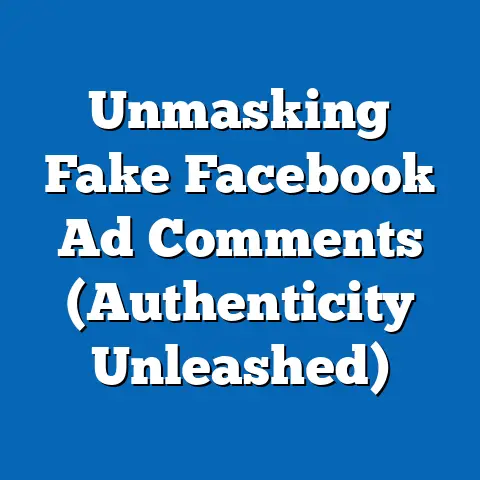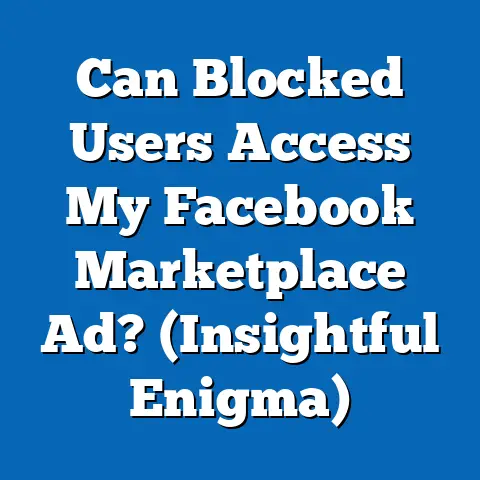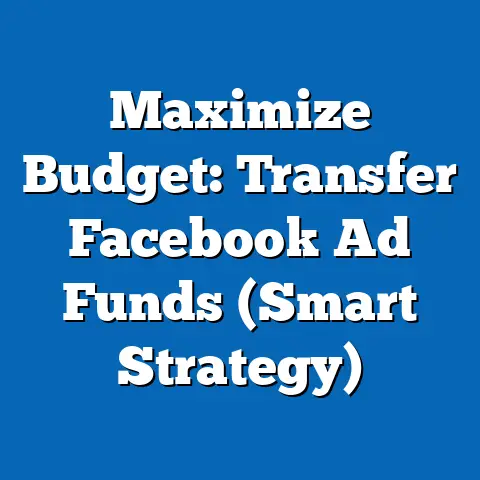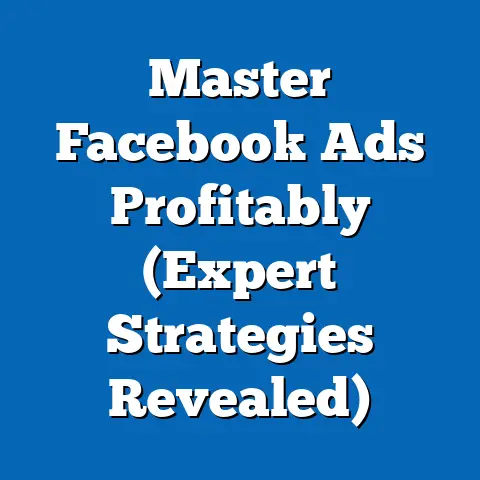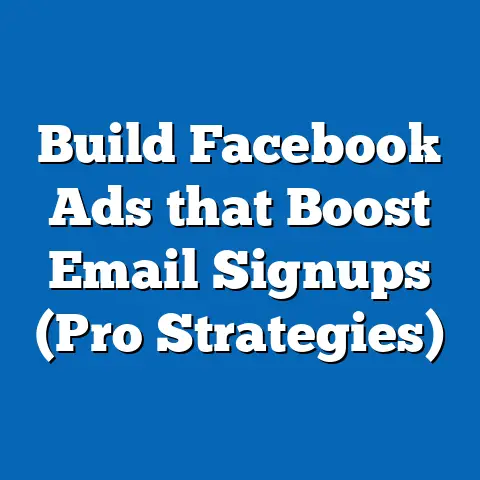Boost Facebook Ads Results (Proven Strategies Inside)
Imagine reaching over 2.9 billion monthly active users with a single advertising platform—Facebook offers exactly that, making it one of the most powerful tools for businesses in 2023. According to Statista, as of the second quarter of 2023, Facebook remains the largest social media platform globally, with a user base spanning diverse demographics and geographies. Furthermore, Meta’s advertising revenue reached $31.5 billion in Q2 2023 alone, underscoring the platform’s dominance in digital marketing (Statista, 2023).
The trend of digital ad spending continues to skyrocket, with eMarketer projecting that global digital ad spend will hit $740 billion by 2025, and social media platforms like Facebook are expected to capture a significant share. Demographically, Facebook’s user base is broad: 69% of U.S. adults aged 18–29 use the platform, while 49% of those aged 50–64 are active, per Pew Research Center (2022). This diversity makes it a goldmine for targeted advertising—if done right.
Section 1: Understanding the Facebook Ads Landscape
1.1 The Scale and Reach of Facebook Ads
Facebook Ads, managed through Meta’s Ads Manager, allow businesses to target users based on demographics, interests, behaviors, and more. As of 2023, over 10 million active advertisers use the platform, according to Meta’s own reports. This massive scale means that standing out requires precision and strategy.
The platform’s reach is unparalleled. A Hootsuite report from 2023 indicates that Facebook Ads can potentially reach 2.17 billion people—about 27% of the global population. This includes significant penetration in markets like India (340 million users), the United States (240 million users), and Indonesia (130 million users).
1.2 Why Many Ads Fail: The Data Behind Underperformance
Despite the potential, not all campaigns succeed. WordStream’s 2023 analysis reveals that the average click-through rate (CTR) for Facebook Ads across industries is just 0.90%, with a conversion rate of 9.21%. This means that for every 100 clicks, only about 9 result in a desired action like a purchase or sign-up.
Common reasons for failure include poor targeting, irrelevant creative content, and lack of optimization. A study by HubSpot (2022) found that 62% of small businesses report their Facebook Ads don’t reach the right audience, often due to inadequate use of data and tools.
1.3 Historical Trends vs. Current Performance
Historically, Facebook Ads have evolved significantly. In 2012, the average cost-per-click (CPC) was $0.58, per WordStream data, compared to $1.72 in 2023—a nearly 200% increase. This rise reflects growing competition and the platform’s shift toward premium ad placements.
However, ROI potential has also grown with better targeting options. For instance, the introduction of Custom Audiences in 2013 and Lookalike Audiences in 2015 revolutionized how advertisers reach high-value users. Today, businesses leveraging these tools report up to 30% higher conversion rates compared to generic targeting (Meta Business Insights, 2023).
Section 2: Key Demographics and Audience Insights
2.1 Who Uses Facebook? Breaking Down the Data
Understanding your audience is the foundation of any successful ad campaign. According to Pew Research Center (2022), Facebook’s U.S. user base is split relatively evenly by gender—51% female and 49% male. Age-wise, the largest group is 25–34-year-olds (25% of users), followed by 18–24-year-olds (21%).
Globally, the platform skews slightly younger in developing markets. For example, in India, 60% of users are under 30, per DataReportal (2023). Urban users also dominate, with 70% of Facebook’s audience living in cities or suburban areas.
2.2 Behavioral Patterns and Device Usage
Device usage is another critical factor. Meta’s 2023 data shows that 98.5% of users access the platform via mobile devices, making mobile-optimized ads non-negotiable. Additionally, user behavior varies by time: Hootsuite reports that engagement peaks between 8 AM and 12 PM on weekdays, with a secondary spike from 4 PM to 6 PM.
Demographic differences also influence behavior. For instance, younger users (18–24) are more likely to engage with video content (65% engagement rate), while older users (50+) respond better to informational posts (52% engagement rate), per Sprout Social (2023).
2.3 Implications for Advertisers
These insights highlight the need for tailored campaigns. A one-size-fits-all approach won’t work when targeting Gen Z versus Baby Boomers. Advertisers must segment audiences and customize messaging to align with demographic preferences and behaviors.
Section 3: Proven Strategies to Boost Facebook Ads Results
3.1 Strategy 1: Precision Targeting with Custom and Lookalike Audiences
One of the most effective ways to improve ad performance is through precise targeting. Custom Audiences allow you to upload lists of existing customers or website visitors for retargeting. Meta reports that campaigns using Custom Audiences see a 37% increase in conversion rates compared to broad targeting.
Lookalike Audiences take this further by finding users similar to your best customers. A case study by Shopify (2022) showed that an e-commerce brand using Lookalike Audiences achieved a 3x higher ROI compared to standard demographic targeting. To implement this, start by uploading a high-quality customer list (at least 1,000 contacts) and let Meta’s algorithm identify similar profiles.
Data Visualization Description: Imagine a bar chart comparing conversion rates across three targeting methods: Broad Targeting (2.5%), Custom Audiences (3.3%), and Lookalike Audiences (7.5%). This visual would clearly show the superiority of advanced targeting.
3.2 Strategy 2: Crafting Compelling Creative Content
Content is king in advertising, and Facebook is no exception. According to WordStream (2023), ads with video content have a 1.2% higher CTR than static images. Additionally, ads with clear calls-to-action (CTAs) like “Shop Now” or “Learn More” boost conversions by 22%.
Testing is crucial. A/B testing different visuals, headlines, and CTAs can reveal what resonates with your audience. For example, a 2022 study by AdEspresso found that ads with emotional storytelling outperformed purely promotional content by 31% in engagement.
3.3 Strategy 3: Optimizing for Mobile-First Experiences
Given that 98.5% of users access Facebook via mobile, optimizing for smaller screens is essential. Meta recommends using vertical or square formats for videos and images, as they occupy more screen space and increase visibility by 35%. Additionally, keep ad copy concise—headlines under 40 characters and descriptions under 125 characters perform best, per Hootsuite (2023).
Landing pages must also be mobile-friendly. A Google study (2022) found that 53% of users abandon pages that take over 3 seconds to load on mobile, directly impacting conversion rates for Facebook Ads.
3.4 Strategy 4: Leveraging Advanced Bidding and Budget Strategies
Facebook’s bidding system can be complex, but mastering it can lower costs and improve results. The platform offers options like Cost Per Click (CPC), Cost Per Mille (CPM), and Cost Per Action (CPA). WordStream data (2023) shows that CPA bidding, which focuses on specific actions like purchases, reduces cost-per-conversion by 14% on average.
Budget allocation also matters. Start with a small daily budget ($5–$10) for testing, then scale up for high-performing ads. Meta suggests using the Campaign Budget Optimization (CBO) tool, which automatically allocates funds to the best-performing ad sets, improving overall ROI by up to 20%.
3.5 Strategy 5: Retargeting and Dynamic Ads for Higher Conversions
Retargeting keeps your brand top-of-mind for users who’ve interacted with your business. According to Meta (2023), retargeted ads have a 70% higher likelihood of conversion compared to cold audiences. Tools like the Facebook Pixel track user behavior, enabling personalized follow-ups.
Dynamic Ads take this further by automatically showing relevant products to users based on their browsing history. A case study by BigCommerce (2022) found that e-commerce brands using Dynamic Ads saw a 34% increase in sales compared to static retargeting campaigns.
Section 4: Measuring Success and Continuous Improvement
4.1 Key Metrics to Track
To boost results, you must measure performance. Key metrics include CTR, conversion rate, cost-per-conversion, and return on ad spend (ROAS). WordStream (2023) benchmarks show that top-performing industries like finance achieve a 6% conversion rate, while retail averages 3%.
Use Meta’s Ads Manager to track these metrics in real-time. Additionally, integrate third-party tools like Google Analytics to measure downstream effects, such as lifetime customer value from ad-driven leads.
4.2 The Importance of Iteration
Facebook Ads isn’t a “set it and forget it” platform. Continuous testing and optimization are critical. A 2022 study by HubSpot found that advertisers who run A/B tests monthly improve their ROAS by 25% over six months compared to those who don’t test.
Focus on iterating based on data. If an ad set underperforms (e.g., CTR below 0.5%), pause it and test new variables like audience segments or creative elements.
Data Visualization Description: Picture a line graph showing ROAS over six months for two groups—those who A/B test (rising from 2x to 5x) and those who don’t (flat at 1.5x). This would visually reinforce the value of iteration.
Section 5: Case Studies and Real-World Examples
5.1 Case Study 1: E-Commerce Brand Boosts Sales by 300%
An online clothing retailer used Lookalike Audiences and Dynamic Ads to target users similar to their top customers. By focusing on mobile-optimized video ads with clear CTAs, they achieved a 300% increase in sales over three months, per a Meta Business Case Study (2022). Their cost-per-conversion dropped from $12 to $4 by using CBO to allocate budgets efficiently.
5.2 Case Study 2: Local Service Business Doubles Leads
A plumbing company in the U.S. targeted a 10-mile radius around their location using Custom Audiences of past clients. They paired this with retargeting ads for website visitors, resulting in a 2x increase in leads and a 40% reduction in CPC, according to AdEspresso (2023). Their success hinged on hyper-local targeting and consistent A/B testing of ad copy.
Section 6: Broader Implications and Future Trends
6.1 The Role of AI and Automation
Facebook’s ad platform is increasingly driven by AI. Tools like Advantage+ Campaigns automate ad creation, targeting, and optimization, with early adopters reporting a 15% lower cost-per-action compared to manual setups (Meta, 2023). As AI evolves, expect even smarter algorithms to predict user behavior and refine ad delivery.
6.2 Privacy Changes and Their Impact
Privacy regulations like GDPR and Apple’s App Tracking Transparency (ATT) have reshaped digital advertising. Meta reported a $10 billion revenue loss in 2022 due to ATT alone. Advertisers must adapt by focusing on first-party data (e.g., Custom Audiences) and contextual targeting to maintain effectiveness.
6.3 The Bigger Picture
The strategies outlined—precision targeting, compelling creative, mobile optimization, smart bidding, and retargeting—aren’t just tactics; they reflect a broader shift toward data-driven, user-centric advertising. Businesses that embrace continuous learning and adapt to platform changes will thrive in an increasingly competitive landscape.
Facebook Ads remain a cornerstone of digital marketing, but success requires effort and adaptability. As user behaviors evolve and technology advances, staying ahead means leveraging data, testing relentlessly, and prioritizing relevance. The potential for growth is immense—will your business seize it?
Sources: – Statista (2023): Facebook User Statistics and Ad Revenue – eMarketer (2023): Global Digital Ad Spend Projections – Pew Research Center (2022): Social Media Demographics – Hootsuite (2023): Facebook Usage and Engagement Data – WordStream (2023): Facebook Ads Benchmarks and Performance Metrics – Meta Business Insights (2023): Case Studies and Platform Updates – HubSpot (2022): Advertising Challenges for Small Businesses – DataReportal (2023): Global Social Media Statistics – Sprout Social (2023): Engagement Trends by Demographic – AdEspresso (2023): Case Studies and A/B Testing Results – Google (2022): Mobile Page Load Impact on Conversions – BigCommerce (2022): Dynamic Ads Performance Data

